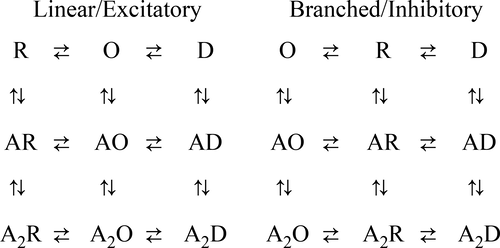当前位置:
X-MOL 学术
›
J. Phys. Chem. B
›
论文详情
Our official English website, www.x-mol.net, welcomes your feedback! (Note: you will need to create a separate account there.)
Path to the Desensitized State of Ligand-Gated Ion Channels: Why Are Inhibitory and Excitatory Receptors Different?
The Journal of Physical Chemistry B ( IF 3.3 ) Pub Date : 2018-01-11 00:00:00 , DOI: 10.1021/acs.jpcb.7b10961 Robert S. Cantor 1
The Journal of Physical Chemistry B ( IF 3.3 ) Pub Date : 2018-01-11 00:00:00 , DOI: 10.1021/acs.jpcb.7b10961 Robert S. Cantor 1
Affiliation

|
The family of pentameric ligand-gated ion channels (pLGICs) includes both inhibitory and excitatory receptors. Electrophysiological methods have explored the time-dependent ion currents induced by their neurotransmitter agonists. Kinetic modeling requires a minimum of three conformational states: resting, active, and desensitized. However, current traces of inhibitory and excitatory pLGICs differ substantially. Reproducing their basic features requires different state connectivity: whether the desensitized state is accessed from the resting or active state. It is surprising that a property as fundamental as state connectivity would differ within the same family. So, we explore the possibility that the connectivity is the same, but corresponding states differ in function: Analogous states on the free energy landscape have similar structure, but differ in ion conductivity, free energies, and agonist binding affinities. This hypothesis is tested using a kinetic model in which agonist and anesthetics modulate the receptor free energy landscape by adsorbing to the membrane in which the receptor is embedded. It was previously shown that even with only three states, the complex behavior observed for GABAAR is reproduced, including its response to anesthetics. It is demonstrated here that this hypothesis accounts for an important difference between inhibitory and excitatory receptors: their opposite responses to inhalation anesthetics.
中文翻译:

配体门离子通道脱敏状态的途径:为什么抑制性受体和兴奋性受体不同?
五聚体配体门控离子通道(pLGIC)家族包括抑制性受体和兴奋性受体。电生理方法已经探究了由其神经递质激动剂诱导的时间依赖性离子电流。动力学建模至少需要三个构象状态:静止,活动和脱敏。然而,目前的抑制性和兴奋性pLGICs的痕迹有很大的不同。再现其基本特征需要不同的状态连通性:脱敏状态是从静止状态还是活动状态访问的。令人惊讶的是,同一个家庭中,与国家连通性同样重要的财产也有所不同。因此,我们探索了连通性相同但相应状态在功能上有所不同的可能性:自由能格局上的类似状态具有相似的结构,但离子电导率,自由能和激动剂结合亲和力不同。使用动力学模型测试该假设,在该动力学模型中,激动剂和麻醉剂通过吸附到嵌入受体的膜上来调节受体自由能态。先前显示,即使只有三个状态,对于GABA观察到的复杂行为甲R为再现时,包括其对麻醉剂的响应。在此证明,该假设解释了抑制性受体和兴奋性受体之间的重要区别:它们对吸入麻醉药的相反反应。
更新日期:2018-01-11
中文翻译:

配体门离子通道脱敏状态的途径:为什么抑制性受体和兴奋性受体不同?
五聚体配体门控离子通道(pLGIC)家族包括抑制性受体和兴奋性受体。电生理方法已经探究了由其神经递质激动剂诱导的时间依赖性离子电流。动力学建模至少需要三个构象状态:静止,活动和脱敏。然而,目前的抑制性和兴奋性pLGICs的痕迹有很大的不同。再现其基本特征需要不同的状态连通性:脱敏状态是从静止状态还是活动状态访问的。令人惊讶的是,同一个家庭中,与国家连通性同样重要的财产也有所不同。因此,我们探索了连通性相同但相应状态在功能上有所不同的可能性:自由能格局上的类似状态具有相似的结构,但离子电导率,自由能和激动剂结合亲和力不同。使用动力学模型测试该假设,在该动力学模型中,激动剂和麻醉剂通过吸附到嵌入受体的膜上来调节受体自由能态。先前显示,即使只有三个状态,对于GABA观察到的复杂行为甲R为再现时,包括其对麻醉剂的响应。在此证明,该假设解释了抑制性受体和兴奋性受体之间的重要区别:它们对吸入麻醉药的相反反应。



























 京公网安备 11010802027423号
京公网安备 11010802027423号